Brenda Austin-Smith
This child is getting scared!
The camera slowly tracks back
The leaves tremble, the street is wet.
-Wim Wenders, Emotion Pictures
The enduring value of the scene, quite apart from its pedagogical value as a teachable segment or a thematic miniature, is its power to enchant, to inspire the kind of movie love that we call cinephilia. It is the scene that draws many of us back to film, “to the unique moment and to that special place-in short, to the quest for plenitude, envelopment, and enclosure […] the enactment of a search for lost time” (Elsaesser 39). Whether re-attached to the larger work by scholarly interest or carefully preserved as a reservoir of intense experience, the scene is a privileged fragment, as likely to be fondly mis-remembered from the one-time screening, as it is to be stored and posted on a personal website for sharing, or for repeated and loving perusal.
The scene I want to describe here is from the road film Alice in the Cities (Wim Wenders, 1974). The scene does not do much straightforward narrative work in this languid film, but provides an example of what I can only call ‘vertiginous cinema’, film that dislocates us both emotionally and physically by representing experience in a way we can’t fully explain, but are completely held in thrall by. This is not simply the dizziness we might feel watching a shot taken from inside a roller coaster, but rather an effect of film’s ability to transform everyday movement into something as exciting as a midway ride, and to register mundane encounters and exchanges in ways that reawaken us to their mystery.
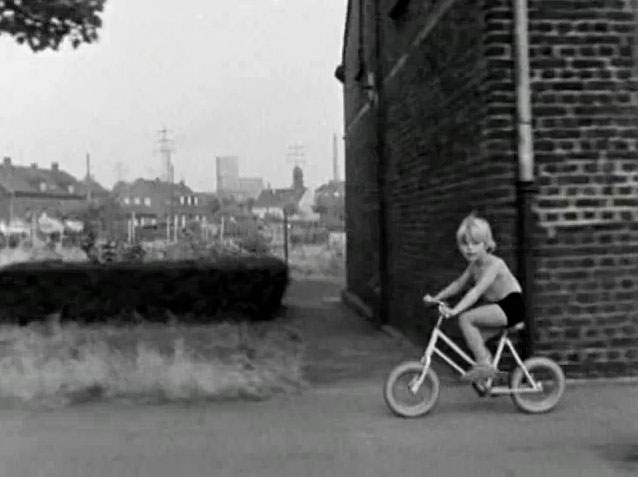
It’s not all that easy to distinguish one scene from another in a road movie. Instead of rooms characters walk into or leave, signaling the start, the development, or the conclusion of a certain thematically significant connection, there is only the vehicle in which they sit, more or less content or unhappy in each other’s company. Stops along the highway offer the most transparent means of effecting shifts in setting, dynamics, and tone, allowing necessity-hunger, an empty gas tank-to structure breaks in the narrative. For characters in road films, scene changes spool by endlessly outside the windows of cars, trucks, and buses, offering themselves as a series of possible sets in which something more permanent could take place between the characters who move through these potentialities without stopping, immune to their picturesque appeals. Each truckstop, convenience store, and backwater town makes the same pitch: ‘C’mon, pull over. Imagine yourself here’. So when the camera fixes on something outside the car window, when something appears to catch the attention of the film itself, and not just its characters, enchantment is a possibility.
Alice in the Cities begins by focusing on the burnt-out German journalist Philip Winter (Rüdiger Vogler), who is travelling across the U.S. on a magazine assignment he is incapable of completing. Fully blocked from writing, he has turned instead to photography. His obsessive picture taking extends the aimlessness of his car trip across the country, the proliferating snapshots he stuffs into his bag as random and disconnected as glances from a car window. Philip’s dependence on the camera, which he uses to document the existence of phenomena as unremarkable as a gas-station and a series of telephone poles, betrays his distance from those objects, and his attempt to know himself through recording their existence. He declares at one point that the pictures never do justice to what one actually sees, but he cannot just look with pleasure at the jumble of images that comprise America. “Not one picture leaves you in peace,” he complains. He is an anticipatory embodiment of what Thomas Elsaesser describes as our contemporary crisis of memory: “Our experience of the present is always already (media) memory, and this memory represents the recaptured attempt at self-presence: possessing the experience in order to possess the memory in order to possess the self” (40).
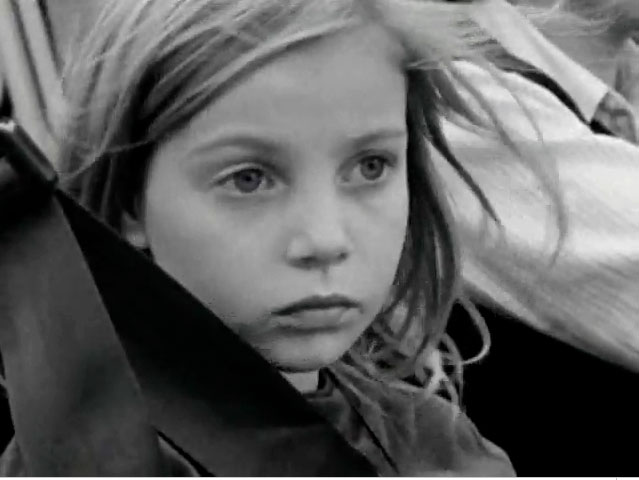
Soon after we meet him, Philip decides to return to Germany. At the airport, he learns of a strike that has grounded all flights to Germany, and meets a woman at the ticket counter (Lisa Kreuzer) who is also trying to return to Germany with her nine-year-old daughter, Alice (Yella Rottländer). He offers assistance and ends up sharing their hotel room while they wait for a flight scheduled to depart the following day. Alice’s mother leaves the hotel to deal with a personal crisis, and in a note, promises Philip she will meet them in Amsterdam. When Alice’s mother does not arrive in Amsterdam the next day, Philip and Alice begin their road trip, looking for Alice’s home.
The scene I have nominated for description here appears about an hour and a half into the film, as the visual climax of a long driving sequence that begins after Philip, frustrated at Alice’s inability to remember what city her grandmother lives in, drives her to a police station and turns her over to the authorities. Later that night, having attended a Chuck Berry concert nearby, he pulls up in front of the hotel they had stayed in the previous night. Suddenly, Alice materializes and climbs into the passenger seat. Philip is surprised but also delighted at her re-appearance. He laughs, recognizing at once her persistence, his loneliness, and their curious bond. They continue their quest. A cut takes us to the next morning, and we see Alice awaken in the back seat. Philip is already sitting at a picnic table, poring over a map. They begin the day’s drive and head to the Ruhr district, where Alice is now certain her grandmother lives. Philip discovers a picture of Alice’s mother tucked in a pocket of Alice’s picture album, and the camera holds this woman’s framed face for a few seconds. The screen goes black, and then the new scene, my scene, begins, with Philip and Alice once more in the rented Renault, driving. This next driving sequence lasts several minutes. It is a slow and dreamy scene of Bazinian realism to which I return over and over again in order to experience the form of exhilarating disorientation caused by a sequence of shots that occurs very near its end.
This is how the scene starts: Philip is at the wheel of the rented car, and the camera films him from the right, Alice’s perspective. For a moment the pensive, repetitive guitar and piano tune that we have heard from time to time throughout the film becomes audible, but fades as Alice and Philip talk about where Philip’s family lives, and how long it has been since he has seen them. The camera cuts between them as they speak. As they drive out of the sunlight and into a tunnel, the camera stays fixed on Philip as the frame goes almost completely dark, the driver’s side mirror a rectangle of reflected light that, as elsewhere in Wenders, repeats the frame of the film itself. Alice places the pictures of her mother and her grandmother’s house on the dashboard, and we see the car drive along a street lined with houses. As they continue driving, their faces are filmed from outside the windshield, the reflections of tree branches overhead appearing to drift over their faces. There is a shot of Alice from outside the car, her face turned to the front and slightly left as unfiltered sunlight floods the middle of the frame, almost washing out her face. The car stops twice, first to let Philip get out and show the picture of the house they are looking for to an elderly couple sitting on a bench. As they drive past old houses slated for demolition, Alice says the empty spaces between the houses look like graves. A few moments later it is Alice’s turn to show the picture to a group of children sitting on a step outside of a brick building.

The scene is a reverie of travel. We see Alice’s eyes almost close as she looks out the car window. She and Philip say little to each other. They are supposed to be watching out for the grandmother’s house, but Alice seems lost in motion and light. Philip pauses the car to ask a cab driver passing in the opposite direction if by chance he knows the location of the house they are looking for. Frustrated, Philip says they will go to Oberhausen to continue their search. He seems to approach an intersection and we see him look left.
And then the camera, filming from what has been Alice’s point of view, cuts to a shot of a young boy, riding a bicycle along the sidewalk, moving from right to left as he pedals to the centre of the frame, slips back to the right, and begins to pedal steadily to keep up with the car. He looks about seven years old. He has blond hair, and is wearing black shorts. When we first see him he is riding in front of an expanse of brick wall between two doors. As he rides alongside the car, diegetic sounds of conversation, and the jabber from the cabbie’s radio cut out, and the melancholy guitar and piano music returns to fill out the soundtrack. The boy is looking at someone inside the car, but we don’t know for certain if it is Alice or Philip, for the reverse shot that would confirm the object of his gaze doesn’t appear. And then it strikes me that the only person he could be looking at is me, us, the viewers. He is looking too directly, too steadily into the camera to be part of the fiction any longer. We have been seen. The shock of being recognized by the film connects us to this boy. The car is still moving through this city, but someone living here has arrested our attention and has also noticed us. We’re not complete strangers in this place anymore.
The boy keeps riding alongside the car. Suddenly another child on a bike speeds by, in front of him, in a blur. But the first boy is still there, trying to stay with us, looking for all the world as if he were aware of the frame, and were playing a game with it as well as with whoever is watching him from the car. He is trying to outrun the right edge of the frame; he is not afraid of it, but knows it is there, and knows that if it catches him, he will stop being for us. The boy looks forward and to his left once again-there is a parked car and he passes behind it, meeting us on the other side, as if making a commitment (‘See you up ahead’). He rides past another door in the continuous brick wall of what must be row house apartments, past a woman leaning against yet another door looking out to the street. He looks forward again as he comes to the end of the row house unit.
There is a cut to Alice’s face, filmed from outside the car, as she looks out of the window, and slightly back. Is she watching the boy on the bike? Her head turns to the front again and she tilts her head up slightly, then back again. There is no sign in her face that she has seen him, that she and he are in the same film world, the way that we and the boy seem to be for those few seconds. Cut to the brick walls of the row houses. The boy on the bicycle is gone. The doors of the row houses pass by. They seem to bulge out slightly. We come to the end of the block-there is a window in the right side of the frame, and a large white ‘H’ in the left, as well as a drainpipe. The sidewalk has dropped below the frameline, out of sight, and the frame itself seems tilted down to the left. And in the next second, as the car turns the corner, the brick building seems to turn, to heave itself heavily towards us in a slow revolution, swinging in slow motion towards us, like Baba Yaga’s house, deep in the forest, forever turning round and round on the legs of a chicken.[1] The brick wall takes up the entire frame. We can see neither its top nor its bottom. It is a vertiginous moment of lost visual bearings, in which the film has the upper hand. Then the car completes its turn, and the end corner of the row house apartments appears on the left side of the frame, re-orienting us.
Somehow in this sequence of shots toward the end of a scene in which two people, recently reconciled, set off on a search together, two accidents of vision have combined to create a visual and emotional experience of attachment and disorientation. The boy on the bicycle is a trouvaille, one of the many with which Wenders seeds his films. His presence in the frame animates perfectly Wenders’s citation of Cezanne’s phrase “Things are disappearing. If you want to see anything, you have to hurry” (Graf 23), as well as Wenders’s belief in the Kracauerian ability of film to ‘redeem’ reality. And when I teach this film I take care to connect its visual tone, its light, its mood, to the state of the two companions, lost in their own worlds, and to the themes and meanings of the film.
But it is really the beauty of the boy on the bike, and the collision of his real afternoon world with the fiction of Philip and Alice, that strikes me each time I see this scene, as I cue it up and play it again. And it is as if the shock of his look across the fictional street of Wenders’s film, which is the real street of his life, and then his sudden loss from the frame, sends me a few moments later careening into that wall-or the wall careening into me. I am for a few seconds knocked out of myself, first because of film’s ability to track the real, and then because of its ability to create an illusion my body believes in. It is this scene that makes me feel, rather than just understand, what representation is.
Notes
[1] Baba Yaga is a witch in Slavic fairy tales, who in some stories helps, and in others eats, lost children. Her hut has no door and no windows, and is perched on the legs of a chicken. Only a spell can reveal how to enter the magic hut: “Turn your back to the forest, your front to me.”
Works Cited
Elsaesser, Thomas. “Cinephilia or the Uses of Disenchantment.” Cinephilia: Movies, Love and Memory. Ed. De Valck, Marijke and Malte Hagener. Amsterdam: Amsterdam UP, 2005. 27-43.
Graf, Alexander. The Cinema of Wim Wenders. London: Wallflower Press, 2002.
Wenders, Wim. Emotion Pictures. London: Faber and Faber, 1989.


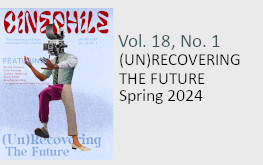
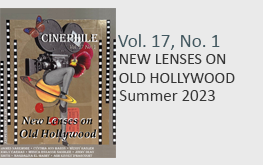
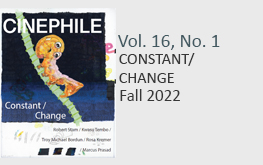
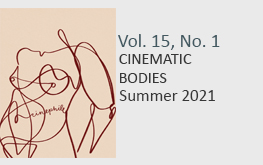
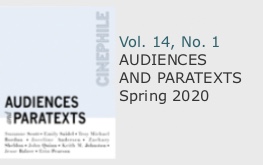
Wim Wenders’ “Alice in the Cities” is about a disinterested togetherness between a German journalist (with a heart of a poet) in the middle of a creative block and a pre-adolescent girl who unexpectedly found herself in his care. It is also about a unique psychological atmosphere which is created by these two protagonists and which becomes the very style of the film – relaxed, tender, warm, more than just life. Thirdly, the film is about creative process when the object of creative effort is life itself. And, finally, it is about the geography of two cultures, American pre-globalist (and impulsively entrepreneurial) and European post-fascist (knowingly existential).
The girl is without any of the usual appealing, without any need for success with other characters (inside the film) or the audience. As a screen presence she is rather shocking for most American viewers. The guy’s creative authenticity can match Alice’s existential one. We see them in New-York and then during their meaningfully absurd trips throughout West Germany. The power of their existential encounter without any expectation of any advantage is strong because they leave life in peace. Only life left in peace can reward people with enlightenment.
The film shows that it is possible to feel together in the world without any sentimental ties. It depicts humanism in psychological action. “Alice…” is a film of moods when visual currents follow the music of emotions with freedom from conventions and strains. It is a film where Being is awakened to human life.
Please, visit: http://www.actingoutpolitics.com to read essay about the film (with analysis of shots) and articles dedicated to films by Godard, Resnais, Bergman, Bunuel, Bresson, Antonioni, Pasolini, Cavani, Kurosawa, Alain Tanner, Rossellini, Bertolucci, Fassbinder, Moshe Mizrahi and Ronald Neame.
You must indulge in a contest for among the very best blogs over the internet.
I’ll suggest this site!